#Cincinnati Union Terminal
Explore tagged Tumblr posts
Text

(@holohedral I think you’ll appreciate this) I’ve been really enjoying studying the colors in the cult friends tunnel(s) - went to Pinterest for more tunnel references and got suggestions for the lovely, delicious abandoned bits of the Cincinnati Union Terminal.
If anyone has favorite tunnels or caves - please send them my way. I want to look at all the nuanced colors and smush them together.
28 notes
·
View notes
Text

Rookwood Pottery Ice Cream | Cincinnati Union Terminal
44 notes
·
View notes
Text
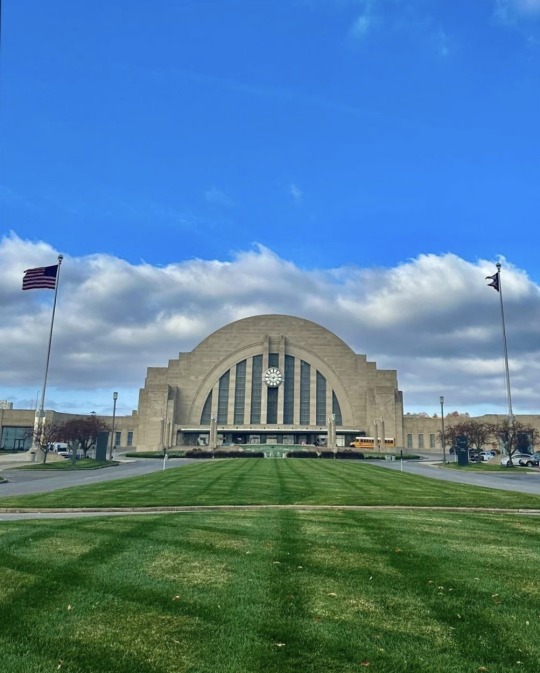
Hall of Justice - the HQ for the Justice League
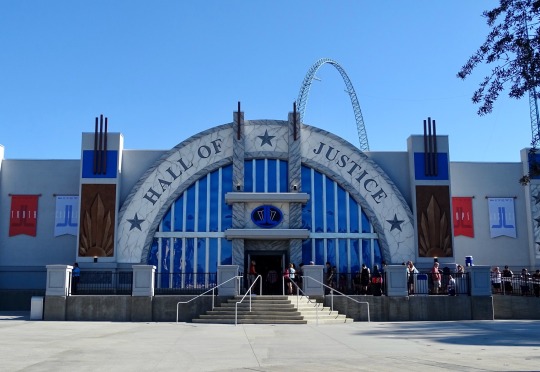
13 notes
·
View notes
Text
Driving For Deco 2024 - A Look Back on Where We've Been: Part One - Netherland Plaza

View On WordPress
#1930&039;s#1931#20th Century Cincinnati#Carew Tower#Cincinnati#Cincinnati Ohio#Cincinnati Union Terminal#Columbus Ohio#DC Big Flea#DC Modernism Show#Driving for Deco#Hilton Netherland Plaza#LeVeque Tower#Louis Grell#NYC Big Flea#Rookwood Pottery#Starrett Brothers#Vintage Modern Expo#W. W. Ahlschlager & Associates
0 notes
Text
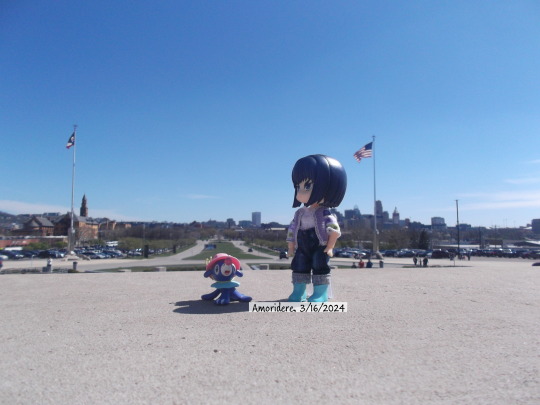
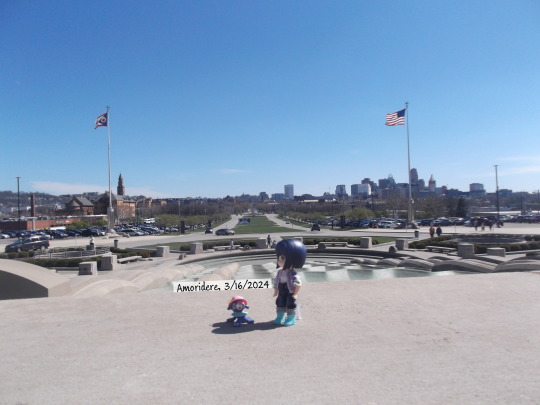
"Union View"
The day before I took these, I didn't get any photos of Satsuki and her "dog" but, however, the day I took these, I did, capturing this view from Union Terminal.
#nendoroid#nendography#finepix jx520#digital photography#fujifilm finepix#signatured#kill la kill#nendoroid doll#fujifilm#popplio#satsuki kiryuuin#shorthaired satsuki#union terminal#cincinnati museum#lady satsuki
2 notes
·
View notes
Text
The Undercover Ensemble performing at the Cincinnati Museum Center, aka Union Terminal, Christmas time, 2013.
"Don't You Worry About A Thing"
The half dome rotunda of this Art Deco train station has quite an echo. Sometimes, a performance can eventually overcome it, as here.
#undercover#undercover ensemble#big band jazz#big band#jazz music#jazz#music#cincinnati#union terminal#cincinnati museum center
2 notes
·
View notes
Text
Deep Sky
The Omnimax showing of Deep Sky was pretty nice.
0 notes
Text
Looks like Cincinnati’s Union Terminal

Looks like the headquarters of the Super Friends

Looks like that rides at the entrance to an attraction at Magic Mountain.


87 notes
·
View notes
Text










La estación Union Terminal de Cincinnati, Ohio, EE. UU.
- Construida por los arquitectos Fellheimer & Wagner y diseñada por Paul Philippe Cret.
-La construcción comenzó en 1928 y la estación se inauguró finalmente en 1933.
- El servicio de trenes finalizó en 1972, pero la corporación Amtrak regresó a la terminal en 1991, retomando así su función como estación de trenes.
- En 1990, la Sociedad Histórica de Cincinnati reutilizó el edificio y se convirtió en el Centro de Museos de Cincinnati.
- La estación se sometió a una renovación exhaustiva entre 2016 y 2018.
- Actualmente alberga el Museo de Historia de Cincinnati, el Museo de Historia Natural y Ciencias, el Teatro Omnimax de la Familia Robert D. Lindner, el Museo Infantil Duke Energy y el Centro de Humanidad y Holocausto Nancy & David Wolf.
- La estructura sirvió de inspiración en el diseño del "Salón de la Justicia", en los cómics de DC.
Fuente: x.com
79 notes
·
View notes
Text
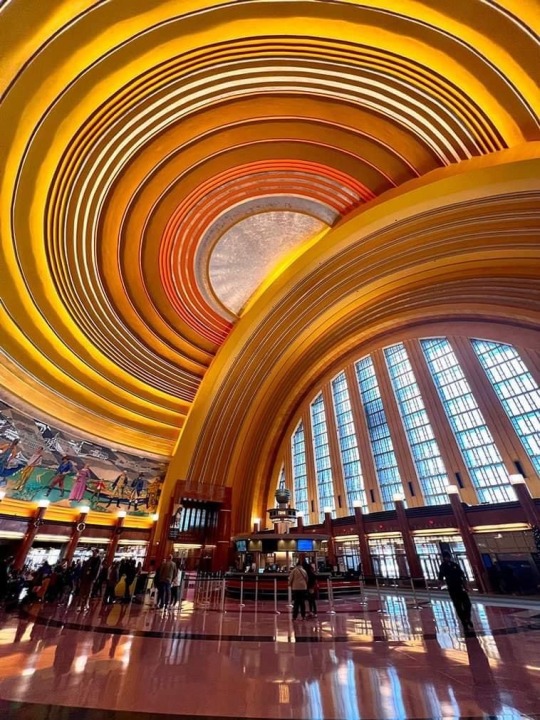
Cincinnati Union Terminal, Ohio, USA
174 notes
·
View notes
Text

Le Cincinnati Union Terminal, Ohio, achevé en 1933 conçu par le cabinet d'architectes Alfred Fellheimer (1875-1959) & Wagner. (Photo Punktoad-Wikimedia). - source The Modernist Collection.
37 notes
·
View notes
Text

Cincinnati Union Terminal is a National Historic Landmark with significant connections to major themes in American history, including transportation, art, architecture, and music.
Union Terminal, an iconic symbol of Cincinnati and one of the most significant Art Deco structures in the country, opened in 1933 with a capacity of 216 trains a day. The second largest half-dome in the world, the 180-foot-wide and 106-foot-tall rotunda features glass mosaic murals by Winold Reiss depicting the history of Cincinnati and the United States. As the Cincinnati Museum Center, the largest cultural institution in the city, Union Terminal houses the Cincinnati History Museum, Cincinnati History Library and Archives, Duke Energy Children’s Museum, Museum of Natural History and Science, and the Robert D. Lindner Family OMNIMAX Theater.
20 notes
·
View notes
Text

Fourth Street East From Vine
Artist: John Caspar Wild (Swiss, 1806-1846)
Date: 1835
Medium: Oil on Canvas
Collection: Cincinnati Museum Center at Union Terminal, Cincinnati, Ohio
#cincinnati in the 1830's#street#buildings#people#architecture#19th century painting#john caspar wild#swiss painter#cincinnati museum center
16 notes
·
View notes
Note
Question does the Hunter's Association have an HQ? And what does it look like (1930's art deco, military inspired...Ramona inspired?)
Also is your HvsH placed on earth itself or in an entirely different world? I apologize for the many questions but i'm just curious.
Also are 'Humans' puppets in this au or are puppets like Eddie and Howdy part of the Mythics?
H.A. is based all over the world with different branches for different countries. They do have a main base but its hidden somewhere out there. As for what it looks like, im taking reference on the Eden Teatro in Portugal, and Cincinnati Union Terminal in America. Here are some pics of them:


The Au takes place in some fantasy world. Its because it gives me a little bit more freedom to make random places and stuff lol, and I wouldnt have to worry about researching too much so I dont portray real life countries wrong
And puppets like Eddie who doesnt have magic in their blood are the humans. Howdy himself isnt a human either, he's like a hybrid
#i just love looking at pretty buildings lol#very much shapes mmmmm#asks#welcome home au#welcome home hvh au
33 notes
·
View notes
Text
Your Great-Grandparents Huffed Laughing Gas, And People Paid To See Them Trip
For the height of entertainment, early Cincinnatians enjoyed dropping by one of the local museums to watch their fellow citizens get stoned. The intoxicating agent was not cannabis or opium or shrooms, although all were readily available, but nitrous oxide or “laughing gas.”
The Western Museum started the trend. Founded in 1818 as one of the earliest scientific museums in the United States, the Western Museum is the ancestor of our Museum Center at Union Terminal. Regardless of its heritage, the institution struggled throughout its existence. Although stocked with fossils, minerals, Native American artifacts and animal specimens, the most popular attractions were grotesque wax figures and monstrosities like two-headed piglets and eight-legged lambs.
The museum directors, Robert Best and Joseph Dorfeuille, soon learned that lectures on scientific topics sold more tickets if they tacked a laughing gas demonstration onto the end of the program. An advertisement in the Liberty Hall and Cincinnati Gazette [30 November 1822] is typical:
“Messrs. Best and Dorfeuille will lecture on various departments of Natural History, and Natural Science, the latter to be illustrated by a great variety of amusing and instructing experiments; among others, they will frequently repeat the administration of the Nitrous Oxide, which has always proved in so high a degree interesting.”
By 1834, the Western Museum had replaced laughing gas with a waxworks replica of Dante’s Inferno, and found a young man to spice up the infernal regions with flashpots and fireworks. His name was Samuel Colt, and he would later build a huge firearms company. While he lived in Cincinnati, however, Colt was a 20-year-old hustler fascinated by laughing gas. He billed himself as “the Celebrated Dr. Coult of New York, London and Calcutta,” and pumped nitrous oxide into anyone who paid for a ticket. His on-stage antics here made news far away. The Albany, New York, Argus [30 July 1833] reported:
“A certain Dr. Coult is administering the nitrous oxyde gas at Cincinnati, and by way of making the entertainment ‘peculiarly attractive,’ the gas is inhaled by a ‘curiously deformed black man.’”
The Daily Cincinnati Republican & Commercial Register [6 November 1834] assured readers that Dr. Coult’s exhibitions at Frederick Frank’s art gallery on Front Street contained “not the least shade of impropriety,” and insisted – no matter how entertaining the effects – this was all about science:
“Dr. Coult’s exhibition presents some of the most pleasing and laughable scenes one can well imagine. – Although the peculiar effects of Nitrous Oxide keeps the audience in a state of almost continual merriment, yet there is a great chance for the learned and curious to exhaust all their wits in sober contemplation of the effects of Nitrous Oxide upon the human system.”

Although nitrous oxide had been known and described by English scientists in the 1700s, the gas remained a psychotropic curiosity until its anesthetic properties were discovered in the 1840s. Its potential as an pain reliever was discovered during an on-stage performance by a medical school dropout named Gardner Quincy Colton. Although Colton later built a dental empire by promoting laughing gas for tooth extractions, he stuck with his profitable stage shows for years. In October 1847, Colton filled the auditorium of Cincinnati’s Melodeon Hall over several nights and the Cincinnati Commercial [2 October 1847] reported on the effects of his laughing gas on some selected subjects.
“The effects were different upon different individuals. “A. after the gas bag was removed from his lips, he stood for a moment, staggered about the stage, and finally fell to the floor. “B. commenced dancing a regular hoe-down with arms and legs in the most violent motion, leaping with all his might into the air, and exhibiting the most tremendous strength. This he continued until the excitement wore off. “C., a young merchant on Liberty street, of slight build, at some imaginary insult became enraged and commenced a furious battle upon those on the stage. Small as he was, it took five or six stout men to hold him until the effects of the gas passed away.”
Another subject was rendered “wonderfully polite and self-complacent” and wandered about the stage, rubbing his hands and bowing to the audience, while the next man up erupted in “silly laughter” while staring dumbly at the assembled onlookers. One young lawyer inhaled deeply, then stood in the most erect posture and recited a poem by William Cullen Bryant. According to the Commercial:
“The effects of the Gas lasted from two to five minutes, and seemed to pass off suddenly, dropping the taker of it down from the highest heaven to earth in an instant. We do not know why this gas should be called laughing gas. Most of the persons who took it on Tuesday evening were most solemnly serious. The whole performance passed off remarkably well, nothing occurring of the least unpleasant nature.”
Twenty years later, Doctor Colton was quite successful with his dental franchises, but still presented public demonstrations. On his 1866 tour through the Queen City, Colton not only recruited women as his subjects, but used them to promote his dental practice. An advertisement in the Cincinnati Gazette [17 April 1866] provides a rather shocking description of his show:
“On the above occasion, after the lecture, twelve ladies will inhale the gas, showing its amusing effects. Breathed in small doses, it exhilarates and develops the character. After which Dr. C. will administer it to several ladies in larger doses, producing profound anesthetic sleep during which he will extract their teeth without their knowledge. He will demonstrate that he has ‘a blessing’ to offer to the citizens of Cincinnati.”
Inevitably, once society latches onto some new exhilarant, reports emerge that insanity lurks within the depths of recreational chemistry. Call it the “Reefer Madness” effect. A Mrs. John Boyer of Cumminsville was sent to Cincinnati’s Longview Hospital for the insane in 1871 after weeks of increasingly erratic behavior were attributed to getting a tooth pulled by a Sixth-Street dentist using laughing gas. In 1867, the death of a Mrs. Bolum on Accommodation Street was found, on the result of autopsy, to have been caused by a strangulated hernia, but her family insisted it was dental nitrous oxide. And the Cincinnati Star [30 September 1876] carried this squib:
“There’s a young woman living in Glendale who, her relatives say, has become mildly insane by the use of laughing gas.”
Wasn’t that the whole point of huffing it anyway?

16 notes
·
View notes
